Ferdinand von Wright
Ferdinand von Wright | |
|---|---|
 Ferdinand von Wright, 1880s | |
| Born | March 19, 1822 |
| Died | July 31, 1906 (aged 84) |
| Nationality | Finnish |
| Known for | Painting |
Ferdinand von Wright (19 March 1822, Haminalahti, near Kuopio - 31 July 1906, Kuopio) was a Finnish painter (belonging to Swedish-speaking population of Finland) - He is best known for his landscapes and animal paintings, especially his detailed depictions of birds, but he also created still-lifes and portraits.[1][2]
Biography[]

Ferdinand von Wright was born at the village of Haminalahti in Kuopio, Finland. His ancestors included Scottish merchants who had settled in Narva during the 17th-Century. His father Henrik Magnus von Wright was a retired Major who owned the family estate, Haminalahden. He was the youngest of nine surviving children and was tutored at home. Two of his older brothers, Magnus von Wright (1805–1868) and Wilhelm von Wright (1810–1887), also became painters and illustrators. Following in their footsteps, he showed an early aptitude for art, developed during time spent hunting and exploring nature while making sketchbooks.[3][4][5]
He travelled to Sweden for the first time when he was fifteen, visiting Bohuslän Province with Wilhelm,[6] who was working as an illustrator for the zoologist Bengt Fredrik Fries (1799–1839).[7]
The following year, he went by himself to work for the Swedish amateur ornithologist, Count Nils Bonde, who had recently subsidized the publication of the multi-volume Svenska Fåglar (Stockholm: C. von Scheele. 1828), with illustrations by Magnus and Wilhelm.[8]
After a few months back in Finland, he returned to Sweden where, in 1842, he briefly studied at the Royal Swedish Academy of Arts with the sculptor Johan Niclas Byström (1783–1848). He went home again in 1844, having been in Sweden for almost six years. Five years later, he went to Turku, where he took some additional lessons from Robert Wilhelm Ekman (1808-1873).[6][9]

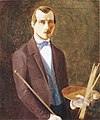
In 1852, he and his brothers went to Helsinki, where he set up a studio and began painting more detailed scenes, rather than individual animals. Six years later, he took a trip to Dresden, where he spent two months studying with the noted animal painter Johann Siegwald Dahl (1827-1902).[10][6] He then travelled to the Swedish island of Orust with Wilhelm, staying for a year.[11]
In 1863, he built a home near his family's estate, which he named "Lugnet" .[12] He lived there for the next twenty years, occasionally spending time with his sisters in Kuopio. In the early 1870s, he had several strokes and was often bedridden,[6] but continued to paint as much as possible. Eventually, he had to move out of the main part of his home and occupy two smaller guest rooms upstairs. He made his last trip in 1881, to Orust, visiting Wilhelm, who was also ill.
His work became more commercial after this and, in 1886 he produced his best-known painting titled The Fighting Capercaillies.[6] In 2006 it got third place in a public vote organized by Ateneum for Finland's "national painting",[13] and in a similar 2013 vote held by Nordic Moneta it was again voted third most significant.[14]


He also contributed articles to various ornithological journals. About this time, he received a state artists' pension.[12] Many former students came to visit and, in the late 1890s, the bird painter (1873–1953) stayed on to be his pupil and assistant. Slowly, he became more withdrawn and died in 1906.[15][16]
Selected paintings[]

From the Garden, Flowers and Birds, 1853–54
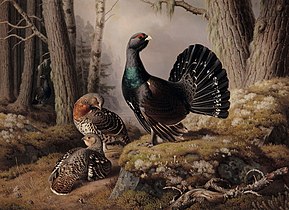
Capercaillies courting, 1862

Magpies round a Dead Woodgrouse, 1867

Mallards, 1874

Pigs and Magpies, 1875
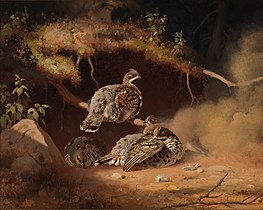
Hazel Grouse Wallowing in Sand, 1877
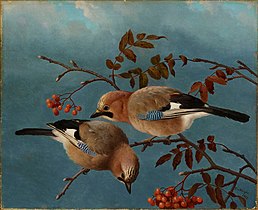
Jays, 1877

The First Surprise, 1880

Ptarmigans, 1893

Partridges in Snow, 1895

Golden Eagle by a Lake, 1897
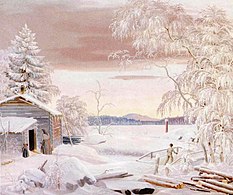
Winter Sunset in Savo Province, 1848

Winter landscape in Haminalahti, 1856

In the Garden of Haminalahti, 1856–57

Landscape in Morning Fog, 1864

Moonlit Oulu, 1867

Haminalahti Landscape, 1853
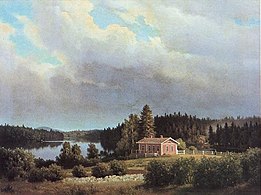
Lugnet Landscape, 1877

Haminalahti Forest Landscape, 1880
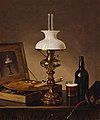
See also[]
- Art in Finland
- Golden Age of Finnish Art
References[]
- ^ Jukka Ervamaa. "Ferdinand Von Wright". Biografiskt lexikon för Finland. Retrieved January 1, 2019.
- ^ Anttonen, Erkki; Pennonen, Anne-Maria (2017). Veljekset von Wright: Taide, tiede ja elämä. Kansallisgalleria. ISBN 9789527067543.
- ^ Jukka Ervamaa. "Magnus, Wilhelm ja Ferdinand". tunturisusi. Retrieved January 1, 2019.
- ^ Peltola, Satu-Lotta (25 October 2017). "Mestarillisten lintumaalareiden tie taiteilijoiksi alkoi metsästyksestä – von Wrightin veljesten tuotanto on muutakin kuin siipiveikkoja". Yle. Retrieved 23 May 2020.
- ^ Ervamaa, Jukka (30 July 2007). "Wright, Ferdinand von (1822 - 1906)". Kansallisbiografia. Retrieved 23 May 2020.
- ^ Jump up to: a b c d e Brief biography @ the University of Jyväskylä website.
- ^ Bengt Hildebrand. "Bengt F Fries". Svenskt biografiskt lexikon. Retrieved January 1, 2019.
- ^ "Svenska fåglar efter naturen och på sten ritade af M. och W. von Wright". doria. Retrieved January 1, 2019.
- ^ Ragnar Josephson. "Johan Niclas Byström". Svenskt biografiskt lexikon. Retrieved January 1, 2019.
- ^ "Johannes Siegvald Dahl, Norsk maler". Salmonsens konversationsleksikon. Retrieved January 1, 2019.
- ^ Aimo Reitala. "Robert Wilhelm Ekman". Biografiskt lexikon för Finland. Retrieved January 1, 2019.
- ^ Jump up to: a b Brief biography @ Lähteillä.
- ^ "Haavoittunut enkeli on suomalaisten suosikkitaulu". Yle. 2 December 2006. Retrieved 23 May 2020.
- ^ Blencowe, Annette (5 February 2013). "Albert Edelfeltin Leikkiviä poikia rannalla äänestettiin Suomen merkittävimmäksi maalaukseksi". Retrieved 22 May 2020.
- ^ "The Fighting Capercaillies. 1886". Finnish National Gallery. Retrieved January 1, 2019.
- ^ "Matti Karppanen". kuopio.fi. Archived from the original on May 12, 2009. Retrieved January 1, 2019.
Further reading[]
- Anto Leikola, Juhani Lokki and Torsten Stjernberg:
- Von Wright -veljesten linnut (“The Birds of the von Wright Brothers”). Otava, 2003. ISBN 951-118-037-1
- Taiteilijaveljekset von Wright: Suomen kauneimmat lintumaalaukset (“The Artist Brothers von Wright: Finland's Most Beautiful Bird Paintings”). Otava, 1986. ISBN 951-109-231-6
- Wilhelm & Ferdinand von Wright dagböcker (journals). Svenska litteratursällskapet i Finland, 2008. ISBN 978-951-5831-37-8
External links[]
| Wikimedia Commons has media related to Ferdinand von Wright. |
![]() Media related to Svenska Fåglar (illustrations) at Wikimedia Commons
Media related to Svenska Fåglar (illustrations) at Wikimedia Commons
- More paintings and drawings by Ferdinand von Wright @ the Kansallis Galleria
- Von Wright's paintings of mallards, a video @ Kantti.net
- "Cultural Path in the Landscape of the Von Wright Brothers"
- 1822 births
- 1906 deaths
- People from Kuopio
- People from the Grand Duchy of Finland
- Swedish-speaking Finns
- Finnish people of Scottish descent
- Finnish nobility
- Animal artists
- Birds in art
- 19th-century Finnish painters
- 19th-century male artists
- Finnish male painters




















